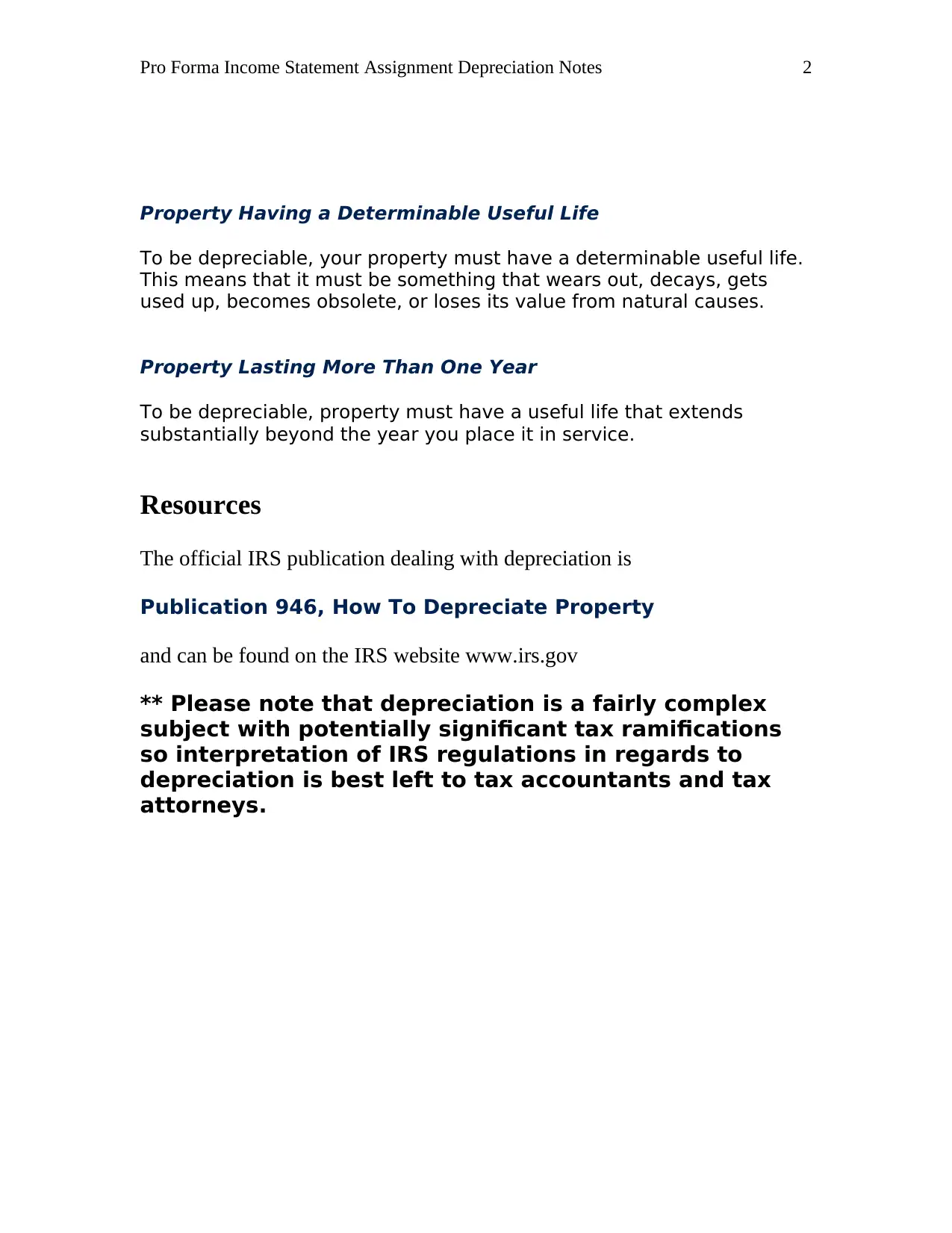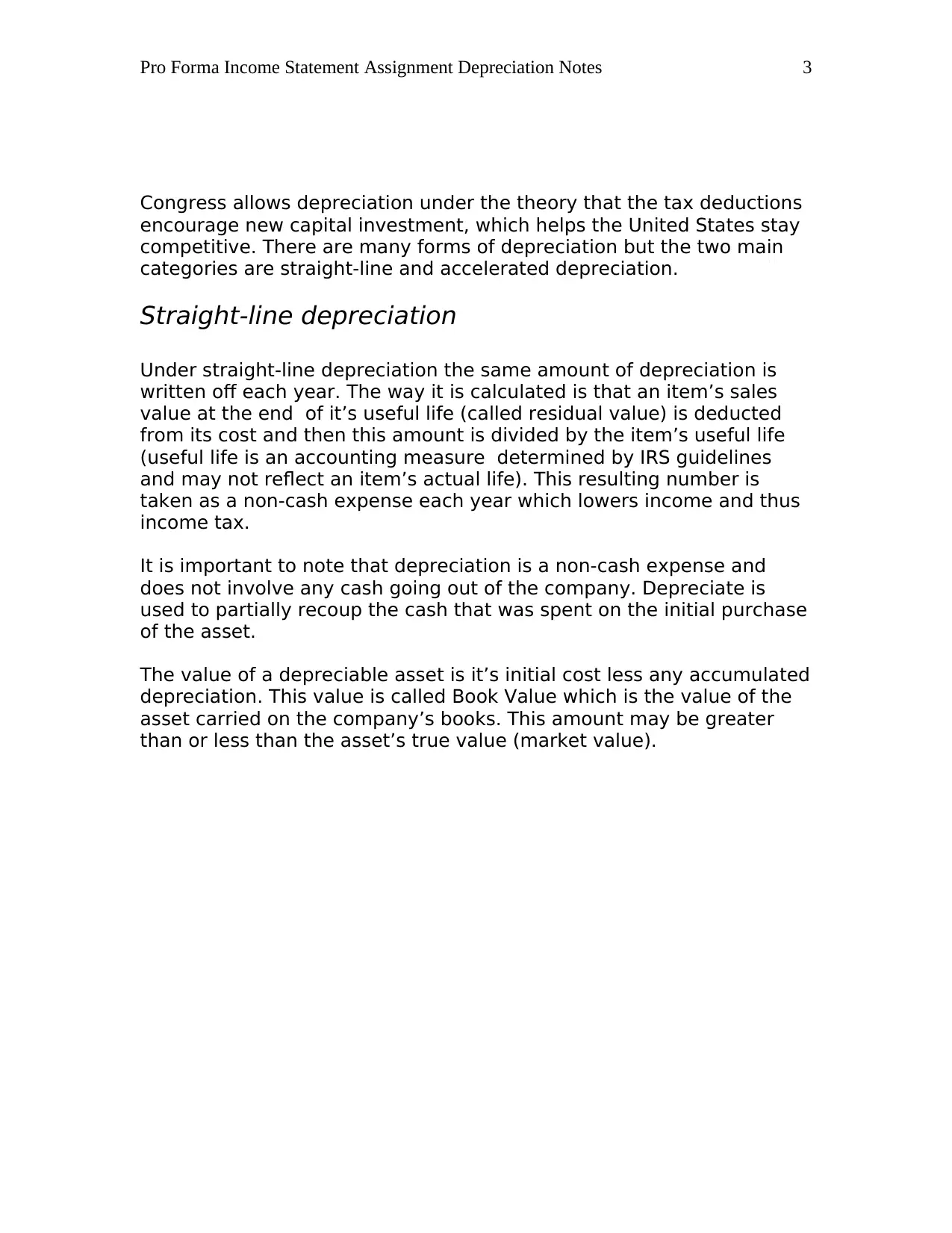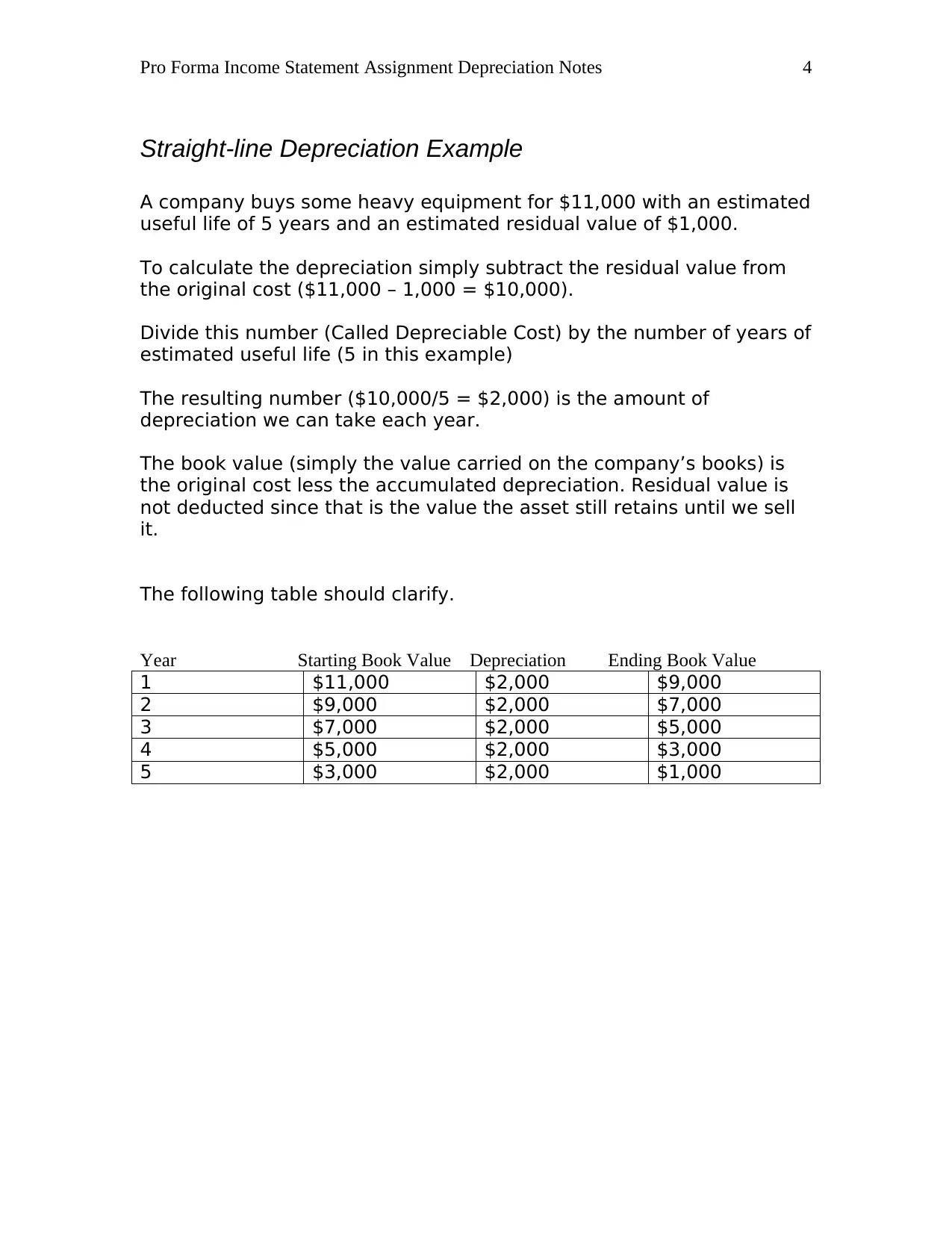Depreciation: Methods, Calculations, and Examples in Finance
VerifiedAdded on 2019/09/24
|6
|1121
|217
Homework Assignment
AI Summary
This assignment provides a comprehensive introduction to depreciation, a key concept in finance and accounting. It explains depreciation as an income tax deduction used to recover the cost of property over time, covering both tangible and intangible assets. The assignment outlines the requirements for property to be depreciable, including ownership, business use, determinable useful life, and lasting more than one year. It then delves into the two primary depreciation methods: straight-line and accelerated depreciation. The straight-line method is explained with a detailed example, illustrating how to calculate annual depreciation expense, book value, and residual value. The assignment also explores accelerated depreciation, specifically the sum of the years' digits (SOYD) method, providing a step-by-step example to demonstrate its calculation. The document emphasizes the importance of depreciation in encouraging capital investment and its impact on tax advantages for businesses. It also highlights that interpretation of IRS regulations is best left to tax professionals.

Pro Forma Income Statement Assignment Depreciation Notes
Depreciation
Introduction
Depreciation is an income tax deduction that allows a taxpayer to
recover the cost of certain property. It is an annual allowance for the
wear and tear, deterioration, or obsolescence of the property.
Most types of tangible property (except, land), such as buildings,
machinery, vehicles, furniture, and equipment are depreciable.
Likewise, certain intangible property, such as patents, copyrights, and
computer software is depreciable.
To be depreciable, the property must meet all the following
requirements.
It must be property you own.
It must be used in your business or income-producing activity.
It must have a determinable useful life.
It must be expected to last more than one year.
Property You Own
To claim depreciation, you usually must be the owner of the property.
You are considered as owning property even if it is subject to a debt.
Property Used in Your Business or Income-Producing Activity
To claim depreciation on property, you must use it in your business or
income-producing activity. If you use property to produce income
(investment use), the income must be taxable. You cannot depreciate
property that you use solely for personal activities.
1
Depreciation
Introduction
Depreciation is an income tax deduction that allows a taxpayer to
recover the cost of certain property. It is an annual allowance for the
wear and tear, deterioration, or obsolescence of the property.
Most types of tangible property (except, land), such as buildings,
machinery, vehicles, furniture, and equipment are depreciable.
Likewise, certain intangible property, such as patents, copyrights, and
computer software is depreciable.
To be depreciable, the property must meet all the following
requirements.
It must be property you own.
It must be used in your business or income-producing activity.
It must have a determinable useful life.
It must be expected to last more than one year.
Property You Own
To claim depreciation, you usually must be the owner of the property.
You are considered as owning property even if it is subject to a debt.
Property Used in Your Business or Income-Producing Activity
To claim depreciation on property, you must use it in your business or
income-producing activity. If you use property to produce income
(investment use), the income must be taxable. You cannot depreciate
property that you use solely for personal activities.
1
Paraphrase This Document
Need a fresh take? Get an instant paraphrase of this document with our AI Paraphraser

Pro Forma Income Statement Assignment Depreciation Notes
Property Having a Determinable Useful Life
To be depreciable, your property must have a determinable useful life.
This means that it must be something that wears out, decays, gets
used up, becomes obsolete, or loses its value from natural causes.
Property Lasting More Than One Year
To be depreciable, property must have a useful life that extends
substantially beyond the year you place it in service.
Resources
The official IRS publication dealing with depreciation is
Publication 946, How To Depreciate Property
and can be found on the IRS website www.irs.gov
** Please note that depreciation is a fairly complex
subject with potentially significant tax ramifications
so interpretation of IRS regulations in regards to
depreciation is best left to tax accountants and tax
attorneys.
2
Property Having a Determinable Useful Life
To be depreciable, your property must have a determinable useful life.
This means that it must be something that wears out, decays, gets
used up, becomes obsolete, or loses its value from natural causes.
Property Lasting More Than One Year
To be depreciable, property must have a useful life that extends
substantially beyond the year you place it in service.
Resources
The official IRS publication dealing with depreciation is
Publication 946, How To Depreciate Property
and can be found on the IRS website www.irs.gov
** Please note that depreciation is a fairly complex
subject with potentially significant tax ramifications
so interpretation of IRS regulations in regards to
depreciation is best left to tax accountants and tax
attorneys.
2

Pro Forma Income Statement Assignment Depreciation Notes
Congress allows depreciation under the theory that the tax deductions
encourage new capital investment, which helps the United States stay
competitive. There are many forms of depreciation but the two main
categories are straight-line and accelerated depreciation.
Straight-line depreciation
Under straight-line depreciation the same amount of depreciation is
written off each year. The way it is calculated is that an item’s sales
value at the end of it’s useful life (called residual value) is deducted
from its cost and then this amount is divided by the item’s useful life
(useful life is an accounting measure determined by IRS guidelines
and may not reflect an item’s actual life). This resulting number is
taken as a non-cash expense each year which lowers income and thus
income tax.
It is important to note that depreciation is a non-cash expense and
does not involve any cash going out of the company. Depreciate is
used to partially recoup the cash that was spent on the initial purchase
of the asset.
The value of a depreciable asset is it’s initial cost less any accumulated
depreciation. This value is called Book Value which is the value of the
asset carried on the company’s books. This amount may be greater
than or less than the asset’s true value (market value).
3
Congress allows depreciation under the theory that the tax deductions
encourage new capital investment, which helps the United States stay
competitive. There are many forms of depreciation but the two main
categories are straight-line and accelerated depreciation.
Straight-line depreciation
Under straight-line depreciation the same amount of depreciation is
written off each year. The way it is calculated is that an item’s sales
value at the end of it’s useful life (called residual value) is deducted
from its cost and then this amount is divided by the item’s useful life
(useful life is an accounting measure determined by IRS guidelines
and may not reflect an item’s actual life). This resulting number is
taken as a non-cash expense each year which lowers income and thus
income tax.
It is important to note that depreciation is a non-cash expense and
does not involve any cash going out of the company. Depreciate is
used to partially recoup the cash that was spent on the initial purchase
of the asset.
The value of a depreciable asset is it’s initial cost less any accumulated
depreciation. This value is called Book Value which is the value of the
asset carried on the company’s books. This amount may be greater
than or less than the asset’s true value (market value).
3
⊘ This is a preview!⊘
Do you want full access?
Subscribe today to unlock all pages.

Trusted by 1+ million students worldwide

Pro Forma Income Statement Assignment Depreciation Notes
Straight-line Depreciation Example
A company buys some heavy equipment for $11,000 with an estimated
useful life of 5 years and an estimated residual value of $1,000.
To calculate the depreciation simply subtract the residual value from
the original cost ($11,000 – 1,000 = $10,000).
Divide this number (Called Depreciable Cost) by the number of years of
estimated useful life (5 in this example)
The resulting number ($10,000/5 = $2,000) is the amount of
depreciation we can take each year.
The book value (simply the value carried on the company’s books) is
the original cost less the accumulated depreciation. Residual value is
not deducted since that is the value the asset still retains until we sell
it.
The following table should clarify.
Year Starting Book Value Depreciation Ending Book Value
1 $11,000 $2,000 $9,000
2 $9,000 $2,000 $7,000
3 $7,000 $2,000 $5,000
4 $5,000 $2,000 $3,000
5 $3,000 $2,000 $1,000
4
Straight-line Depreciation Example
A company buys some heavy equipment for $11,000 with an estimated
useful life of 5 years and an estimated residual value of $1,000.
To calculate the depreciation simply subtract the residual value from
the original cost ($11,000 – 1,000 = $10,000).
Divide this number (Called Depreciable Cost) by the number of years of
estimated useful life (5 in this example)
The resulting number ($10,000/5 = $2,000) is the amount of
depreciation we can take each year.
The book value (simply the value carried on the company’s books) is
the original cost less the accumulated depreciation. Residual value is
not deducted since that is the value the asset still retains until we sell
it.
The following table should clarify.
Year Starting Book Value Depreciation Ending Book Value
1 $11,000 $2,000 $9,000
2 $9,000 $2,000 $7,000
3 $7,000 $2,000 $5,000
4 $5,000 $2,000 $3,000
5 $3,000 $2,000 $1,000
4
Paraphrase This Document
Need a fresh take? Get an instant paraphrase of this document with our AI Paraphraser

Pro Forma Income Statement Assignment Depreciation Notes
Accelerated Depreciation
The other main type of depreciation is accelerated. With accelerated
depreciation more depreciation is deducted in the earlier years.
There are several different ways to calculate accelerated depreciation
but one of the most common is Sum of the Years Digits (SOYD).
With Sum of the Years Digits, simply add up the number of years of
useful life and use this as the bottom number (denominator) of a
fraction with the top number (numerator) being the years of useful life
counting backwards. An example should clarify.
Accelerated Depreciation Example
$10,000 piece of capital equipment, no residual value, 4 years
estimated useful life.
Accelerated Depreciation
Step 1: Add up the years of useful life. Since there are 4 years we add
up
4 + 3 + 2 + 1 = 10.
Step 2: Create 4 fractions (4 years of useful life) starting with the
largest to the smallest and multiply each fraction times the cost.
4 x $10,000 = $4,000 Year 1
10
3 x $10,000 = $3,000 Year 2
10
2 x $10,000 = $2,000 Year 3
10
1 x $10,000 = $1,000 Year 4
10
Year Starting Book Value Depreciation Ending Book Value
1 $10,000 $4,000 $6,000
5
Accelerated Depreciation
The other main type of depreciation is accelerated. With accelerated
depreciation more depreciation is deducted in the earlier years.
There are several different ways to calculate accelerated depreciation
but one of the most common is Sum of the Years Digits (SOYD).
With Sum of the Years Digits, simply add up the number of years of
useful life and use this as the bottom number (denominator) of a
fraction with the top number (numerator) being the years of useful life
counting backwards. An example should clarify.
Accelerated Depreciation Example
$10,000 piece of capital equipment, no residual value, 4 years
estimated useful life.
Accelerated Depreciation
Step 1: Add up the years of useful life. Since there are 4 years we add
up
4 + 3 + 2 + 1 = 10.
Step 2: Create 4 fractions (4 years of useful life) starting with the
largest to the smallest and multiply each fraction times the cost.
4 x $10,000 = $4,000 Year 1
10
3 x $10,000 = $3,000 Year 2
10
2 x $10,000 = $2,000 Year 3
10
1 x $10,000 = $1,000 Year 4
10
Year Starting Book Value Depreciation Ending Book Value
1 $10,000 $4,000 $6,000
5

Pro Forma Income Statement Assignment Depreciation Notes
2 $6,000 $3,000 $3,000
3 $3,000 $2,000 $1,000
4 $1,000 $1,000 $0
Congress allows Accelerated Depreciation as it tends to encourage
businesses to continuously buy new capital equipment, which keeps
American Industry competitive, since companies get increased tax
advantages in the early years of capital equipment’s useful life.
6
2 $6,000 $3,000 $3,000
3 $3,000 $2,000 $1,000
4 $1,000 $1,000 $0
Congress allows Accelerated Depreciation as it tends to encourage
businesses to continuously buy new capital equipment, which keeps
American Industry competitive, since companies get increased tax
advantages in the early years of capital equipment’s useful life.
6
⊘ This is a preview!⊘
Do you want full access?
Subscribe today to unlock all pages.

Trusted by 1+ million students worldwide
1 out of 6
Related Documents
Your All-in-One AI-Powered Toolkit for Academic Success.
+13062052269
info@desklib.com
Available 24*7 on WhatsApp / Email
![[object Object]](/_next/static/media/star-bottom.7253800d.svg)
Unlock your academic potential
Copyright © 2020–2025 A2Z Services. All Rights Reserved. Developed and managed by ZUCOL.





